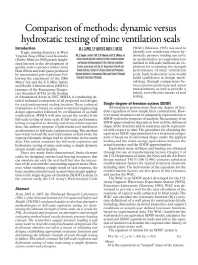Mining Publication: Comparison of Methods: Dynamic Versus Hydrostatic Testing of Mine Ventilation Seals
Original creation date: September 2008
From 2001 to 2007, the Pittsburgh Research Laboratory (PRL) of the National Institute for Occupational Safety and Health (NIOSH) conducted studies to develop alternative methodologies to full-scale explosion testing for determining the ultimate strength of mine seals. As a result, the PRL developed and proposes an alternative seal-strength evaluation method based on a hydrostatic pressure-loading concept. The researchers suggest pressure loading a seal using water to twice the expected dynamic design load. The hydrostatic chamber test offers a means of validating seal designs, establishing appropriate resistance functions and determining the ultimate strength of seals through testing to failure. This article contrasts the full-scale explosion and hydrostatic testing of mine seals using a simple dynamic system model and principles.
Authors: MJ Sapko, SP Harteis, ES Weiss
Peer Reviewed Journal Article - September 2008
NIOSHTIC2 Number: 20034425
Min Eng 2008 Sep; 60(9):147-153
See Also
- Clearing the Air
- Demonstration of Safety Plugging of Oil Wells Penetrating Appalachian Coal Mines
- Explosion Pressure Design Criteria for New Seals in U.S. Coal Mines
- Inflatable Partitions for High-Expansion Foam Generators
- Programmable Electronic Mining Systems: Best Practice Recommendations (In Nine Parts): Part 8: 6.0 Safety File Guidance
- Progress Toward Improved Engineering of Seals and Sealed Areas of Coal Mines
- Strength Characteristics and Air-Leakage Determinations for Alternative Mine Seal Designs
- Strengthening Existing 20-psi Mine Ventilation Seals With Carbon Fiber-Reinforced Polymer Reinforcement
- Use of Ground Penetrating Radar and Schmidt Hammer Tests to Determine the Structural Integrity of a Mine Seal
- Use of Pressure Swing Adsorption Technology to Inert Sealed Mine Areas with Nitrogen
- Content source: National Institute for Occupational Safety and Health, Mining Program


 ShareCompartir
ShareCompartir
